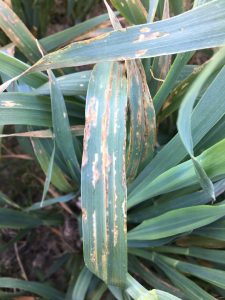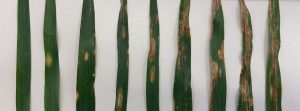Stripe and Halo blight are the two bacterial diseases commonly found infecting oat crops in Victoria. Surveys found Bacterial blight in 55 per cent of oat crops in Victoria, with higher incidence levels in higher rainfall zones. However, the severity was low and unlikely to cause grain/hay yield losses.
What to look for
Symptoms of stripe and Halo blight appear similar during early infection stages. Initially both produce water-soaked spots on oat leaves, but these differ as they mature. Symptoms of Stripe blight lengthen and form red-brown stripes with yellow and red margins. The lesions often merge and form irregular necrotic blotches causing leaves to senesce prematurely. Halo blight produces a yellow-green halo around the yellow-brown oval shaped water-soaked spots. These spots later grow and merge with lesions causing large irregular necrotic blotches. Severe infections often lead to premature senescence of leaves.
Disease Cycle
There is limited information about the epidemiology of both stripe (caused by Pseudomonas syringae pv. striafaciens) and halo (caused by Pseudomonas syringae pv. coronafaciens) blights in Australia. It is understood that the bacteria survive between seasons on seed and stubble, while rain splash distributes bacteria amongst surrounding plants. Bacterial infections usually coincide with mid-tillering and affect all growth stages thereafter.
Economic Importance
The impact of these diseases on oat hay and grain yield is yet to be determined in Australia. Recent surveys in Victoria have indicated that Bacterial blight is the second most prevalent disease of oats following RLL. Although low incidence levels are present in most of the infected paddocks, there is potential for losses to susceptible varieties during favourable seasons.
Management
Cultural Practices
Infected seed and stubble are the primary sources for bacterial diseases. Avoid sowing into oat stubble to reduce the risk of Bacterial blight. Crop rotations with other crops that are less susceptible to bacteria should be considered.
Resistant Varieties
Growing Moderately Susceptible (MS) or better rated varieties will reduce risk of loss. Susceptible (S) to Very Susceptible (SVS) rated varieties may incur losses during seasons favourable. See a current Cereal Disease Guide or the NVT website for up-to-date ratings.
Chemical control
There are no known chemical control options for Bacterial blights. Being a bacteria, it is not controlled by fungicides.




